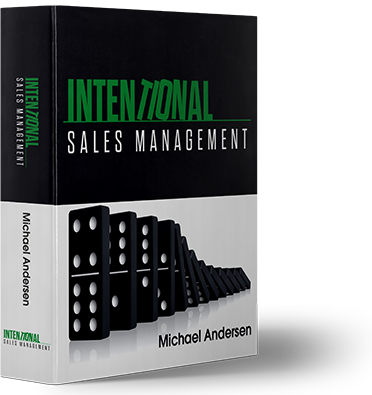Turn-key Sales Management Training
to Put You in the Driver’s Seat of Your Sales Team
Intentional Sales Management™ (ISM™) empowers sales managers to become true leaders with all the tools, best practices, and understanding necessary to develop and orchestrate a high-caliber sales team.
We find that often, managers are promoted into their roles by being successful salespeople, not necessarily because they have mastered best practices for getting consistent results, let alone leading a team in doing so. Many don’t even think it’s possible to expect consistency or predictability or to create true accountability among salespeople.
ISM™ is the system that shows that it can be done and provides the comprehensive knowledge, training, and tools to make it happen.


Intentional Sales Management™ (ISM™) empowers sales managers to become true leaders with all the tools, best practices, and understanding necessary to develop and orchestrate a high-caliber sales team.
We find that often, managers are promoted into their roles by being successful salespeople, not necessarily because they have mastered best practices for getting consistent results, let alone leading a team in doing so. Many don’t even think it’s possible to expect consistency or predictability or to create true accountability among salespeople.
ISM™ is the system that shows that it can be done and provides the comprehensive knowledge, training, and tools to make it happen.
We have found that achieving predictable sales stems largely from creating the right sales team culture
All members are placed in roles where their strengths will be an asset, and they are provided with clear systems and tools to facilitate use of best practices. Crucially, developmental support and accountability are individualized in order to be appropriate to each salesperson’s level of skill, knowledge, and performance.
We have found that achieving predictable sales stems largely from creating the right sales team culture
All members are placed in roles where their strengths will be an asset, and they are provided with clear systems and tools to facilitate use of best practices. Crucially, developmental support and accountability are individualized in order to be appropriate to each salesperson’s level of skill, knowledge, and performance.
Team Balloon Model™
To accomplish this individualization, we have developed the Team Balloon Model™, a proprietary framework that encapsulates effective sales management in a simple graphic form, with profound implications and powerful results.
The model groups salespeople into three distinct categories based on their level of performance. You can think of these categories as three water balloons stacked on top of each other, with high performers in the top and low performers in the bottom. The team’s overall results are measured by how high the stacked balloons reach.
When you lay a water balloon on the ground, it spreads out like a pancake. But if you shape it within the walls of a box, it stands up tall. The same thing happens with sales teams. Without the right structure, each team’s efforts flatten out, and overall results suffer.

The manager’s role is to provide the structure that keeps the balloons contained and pushing results higher, and this is achieved by providing the appropriate types of support and accountability for each balloon motivating them get the results.
Some managers put too much emphasis on accountability. They tend to push their salespeople to do and achieve more without coaching, mentoring, and motivating them get the results they’re demanding. They create a culture of animosity and demoralization that undermines performance, and they ultimately fail as managers.
On the other hand, managers who focus on support while neglecting to foster accountability become glorified cheerleaders. They give their people everything while not actually requiring anything. It all gets taken for granted, and ultimately they don’t get the results they work so hard to generate.
In the Team Balloon Model™, the lowest performing salespeople form the bottom level. The manager’s role with this group is to determine whether they can move into a higher balloon or must exit the company. At the top of the stack, the highest performers only need manager support to move specific mountains out of their way so they can be even more successful. The bulk of the manager’s focus is therefore on the middle group, helping them advance into the upper tier so they too can become top-performing rainmakers.
The 8 Core Meetings
Team Balloon Model™

To accomplish this individualization, we have developed the Team Balloon Model™, a proprietary framework that encapsulates effective sales management in a simple graphic form, with profound implications and powerful results.
The model groups salespeople into three distinct categories based on their level of performance. You can think of these categories as three water balloons stacked on top of each other, with high performers in the top and low performers in the bottom. The team’s overall results are measured by how high the stacked balloons reach.
When you lay a water balloon on the ground, it spreads out like a pancake. But if you shape it within the walls of a box, it stands up tall. The same thing happens with sales teams. Without the right structure, each team’s efforts flatten out, and overall results suffer.
The manager’s role is to provide the structure that keeps the balloons contained and pushing results higher, and this is achieved by providing the appropriate types of support and accountability for each balloon motivating them get the results.
Some managers put too much emphasis on accountability. They tend to push their salespeople to do and achieve more without coaching, mentoring, and motivating them get the results they’re demanding. They create a culture of animosity and demoralization that undermines performance, and they ultimately fail as managers.
On the other hand, managers who focus on support while neglecting to foster accountability become glorified cheerleaders. They give their people everything while not actually requiring anything. It all gets taken for granted, and ultimately they don’t get the results they work so hard to generate.
In the Team Balloon Model™, the lowest performing salespeople form the bottom level. The manager’s role with this group is to determine whether they can move into a higher balloon or must exit the company. At the top of the stack, the highest performers only need manager support to move specific mountains out of their way so they can be even more successful. The bulk of the manager’s focus is therefore on the middle group, helping them advance into the upper tier so they too can become top-performing rainmakers.
The 8 Core Meetings

The functional underpinning that coordinates with the theoretical framework of the Team Balloon Model™ is a set of eight core meetings, with specific agendas and prescribed cadence to make the manager’s duties as easy to fulfill as possible.
- Sales Focus Blueprint™
- Pre-Call Plan
- Post-Call Debrief
- Sales Team Meeting
- One-on-One Mentoring
- One-on-One Debrief
- Activity Review
- Funnel Review
Properly executed, this set of meetings covers the majority of the spectrum of managerial functions in a systematic way that provides the basis for team systemization and the predictable sales results we’re aiming for.
Core Elements – Partial List
HIRING

When done right, hiring is an ongoing process. Its perpetual nature complements the Team Balloon Model™. A manager’s ability to hold their team accountable is drastically enhanced when they have a steady flow of potential talent they can access as needed, such as when it’s time to release the lowest performers in the Assess Balloon, or when their best Partner level salesperson leaves through no fault of the manager.
Team Sculpting™ – This is our four-part methodology for continuous recruitment and hiring, which focuses on the following components:
- Identification – Determining exactly what skills and abilities the role requires
- Evaluation – Screening and interviewing potential candidates
- Recruiting – Coming to an agreement about the role and work terms with your candidate and getting their buy-in for your company culture
- Hiring – Making the offer and finalizing the agreement
Onboarding and Delegation – Mirroring the Team Sculpting™ system, we follow a 4-step process for getting new hires up to speed.
- Watch Me – The new hire learns by observing the manager or trainer
- Cooperate – The new hire learns by cooperatively tackling projects with the trainer
- Watch Them – The new hire takes the reins, while the trainer observes and evaluates their execution
- Onboarded – The new hire has demonstrated they can own their role and responsibilities with minimal oversight
Coaching / Mentoring

A great sales manager is an expert coach and mentor. A core function of the role is to foster the continual professional development of their team.
Mentorship Ladder™ – On ISM™’s seven-rung Mentorship Ladder™, each rung represents increased levels of trust, and therefore effectiveness, in mentorship between manager and protégé. This framework represents a tested path toward attaining a deep symbiotic relationship.
Coaching Spectrum™ – Many different kinds of communication can fall under the umbrella of coaching. Managers need to understand each style and how and when to use it in order to best succeed with their team. ISM™ identifies five different types of coaching within the Coaching Spectrum™. This framework guides sales managers in determining how and when to use each approach with different salespeople to attain the best results.
Accountability

As we’ve discussed, accountability is one of the two key structural components of successful sales management.
Sales Focus Blueprint™ – Each salesperson creates benchmarks with their manager that define their success in the job based on desired earnings and other achievements. Then, they reverse engineer those goals to develop appropriate milestones such as: daily driver activities, deal/focus areas to work, and expected results to strive for. Rather than having quotas handed down from management, this process helps salespeople clearly define a success path toward sales goals that they are personally motivated to achieve, making it much more likely they will achieve them.
Funnel Review Meeting – This is one of the eight key sales management meetings, and the agenda is specifically designed to allow managers to quickly validate the real status of the deals a salesperson is working on. It removes any biases or hopeful thinking they may be bringing to the deal, helping clarify opportunities, improve forecasting, and ensure they’re not jumping ahead of the customer or missing critical indicators.
Motivation

In order to steer a sales team toward the desired results, it’s critical that the manager understands what motivates them and provides those things both in the basic compensation structure as well as through special incentives to keep salespeople on track.
Rewards Diamond™ – This framework helps managers put together contests, rewards, focused accountability measures, and other motivators to drive specific behaviors. Such initiatives should not be overused or take the place of an effective compensation system, but organized for specific purposes at appropriate times. We emphasize designing these types of incentives so they’re seen as neither gimmicky nor burdensome by the team, but rather something that’s meaningful and valuable to their success.
Compensation – Most sales compensation systems sit on a spectrum of salary vs. commission. This is a fool’s choice, as salary provides little motivation, and if there is a commission, it is often based on top-line results rather than profitability. What’s needed is a system that rewards not only results, but behavior (best practices), and aligns the company’s goals with the salesperson’s. Compensation systems should provide a map to success for the salesperson and be simple enough to be calculated in their head at the time of sale. Without these key factors, compensation fails to truly drive behavior, and results therefore become less predictable.
What’s Included
Following is a partial list of available modules:

Core Responsibilities
Core Responsibilities

Coaching and Training – Understanding the difference between doing, teaching, and coaching
Mentoring – Keys to understanding what drives the salesperson and how to help them see their better future
Motivation – Knowing how to properly motivate salespeople without feeling like a cheerleader or a tyrant
Accountability Partnership – Identifying best practices in selecting the right metrics, ensuring buy-in, and corrective actions
Team Sculpting™ – How to consistently recruit, screen, maintain on-deck candidates, and hire best-fit salespeople

Meetings Execution
Meetings Execution

Meetings Overview – Understanding the cadence, audience, and prioritization of the eight core meetings and how they fit together in the overall process of managing a sales team
Sales Focus Blueprint™ – A method of walking a salesperson through a comprehensive sales planning process in a way that gets their buy-in not just conceptually, but at the activity level
Pre-Call Plan – A tested formula for ensuring that a sales call will accomplish the most that it can
Post-Call Debrief – Focuses on accountability to the sales strategy, recognizing skill gaps, and providing constructive feedback
Sales Team Meeting – How to conduct a team meeting that salespeople want to attend and that facilitates consistent usage of best practices
One-on-One Mentoring – Truly creating a trust connection between manager and salesperson with the goal of enhancing their career
One-on-One Debrief – Focuses on goals, results, and needs for assistance while minimizing responsibility avoidance
Activity Review – Re-evaluating the activity levels that are going to bring success and spotting activity trends
Funnel Review – Understanding funnel concepts, process gates, deal progress proofs, forecastability, and metrics. Includes gut-checking opportunities to ensure process compliance and identifying stuck deals
Out in the Field – Core responsibilities that put you the manager in front of customers. Defines roles for a 4-legged sales call and maximizes the impact of field time with the salesperson

Specialized Skill Sets
Specialized Skill Sets

Onboarding & Delegation – A system for training and on-boarding new salespeople that ensures success without frustration
Uncovering Beliefs – Coaching to uncover the hidden reasons salespeople who know a better way won’t use it
Gamification – A potpourri of ideas and best-practices when using competition and focused incentives as sales prods
Compensation – How to design compensation so that there is a proper balance between results and activity
Account Management – A system for identifying which customers should receive focus and ensuring that focus is delivered
Ready to intensify your sales results?

Clarify Your View
OSA™ enables us to conduct a comprehensive analysis of your company’s strategy, marketing positioning, organizational structure, and team makeup.

Sales Best Practices
Client Builder™ sales training provides companies and sales professionals with a proven, practical road map for filling their prospecting pipelines, improving their closing ratio, and increasing sales.

Get to Know Michael
Learn more about the creator of Culture of Sales Solutions™ and what drives him to help companies transform their sales.
Clarify Your View

OSA™ enables us to conduct a comprehensive analysis of your company’s strategy, marketing positioning, organizational structure, and team makeup.
Sales Best Practices

Client Builder™ sales training provides companies and sales professionals with a proven, practical road map for filling their prospecting pipelines, improving their closing ratio, and increasing sales.
Get to Know Michael

Learn more about the creator of Culture of Sales Solutions™ and what drives him to help companies transform their sales.
